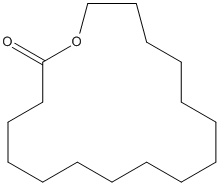Hexadecalactone
General
Type : Lactone || Ring opening polymerization substrate || Hexadecanoate || Palmitate
Chemical_Nomenclature : oxacycloheptadecan-2-one
Canonical SMILES : C1CCCCCCCC(=O)OCCCCCCC1
InChI : InChI=1S\/C16H30O2\/c17-16-14-12-10-8-6-4-2-1-3-5-7-9-11-13-15-18-16\/h1-15H2
InChIKey : LOKPJYNMYCVCRM-UHFFFAOYSA-N
Other name(s) : 16-Hexadecanolide, Hexadecanolide, hexadecanolactone, omega-hexadecalactone, Dihydroambrettolide, 16-Hexadecanolactone, SCHEMBL111372, CHEMBL3189021, ZINC3875762, 1,16-Hexadecanolide, Oxacycloheptadecan-2-one, Juniperic acid lactone, Hexadecanoic acid, 16-hydroxy-, .omicron.-lactone

Target
Families : Canar_LipB
References (3)
| Title : Exploring the Solid State Properties of Enzymatic Poly(amine-co-ester) Terpolymers to Expand their Applications in Gene Transfection - Voevodina_2014_RSC.Adv_4_8953 |
| Author(s) : Voevodina I , Scandola M , Zhang J , Jiang Z |
| Ref : RSC Adv , 4 :8953 , 2014 |
| Abstract : Voevodina_2014_RSC.Adv_4_8953 |
| ESTHER : Voevodina_2014_RSC.Adv_4_8953 |
| PubMedSearch : Voevodina_2014_RSC.Adv_4_8953 |
| PubMedID: 24683469 |
| Gene_locus related to this paper: canar-LipB |
| Title : Polymers from functional macrolactones as potential biomaterials: enzymatic ring opening polymerization, biodegradation, and biocompatibility - van der Meulen_2008_Biomacromolecules_9_3404 |
| Author(s) : van der Meulen I , de Geus M , Antheunis H , Deumens R , Joosten EA , Koning CE , Heise A |
| Ref : Biomacromolecules , 9 :3404 , 2008 |
| Abstract : van der Meulen_2008_Biomacromolecules_9_3404 |
| ESTHER : van der Meulen_2008_Biomacromolecules_9_3404 |
| PubMedSearch : van der Meulen_2008_Biomacromolecules_9_3404 |
| PubMedID: 18975906 |
| Title : A comparison of lipase-catalysed ester and lactone synthesis in low-water systems: analysis of optimum water activity - Alston_2002_Biotechnol.Bioeng_77_641 |
| Author(s) : Alston MJ , Freedman RB |
| Ref : Biotechnol Bioeng , 77 :641 , 2002 |
| Abstract : Alston_2002_Biotechnol.Bioeng_77_641 |
| ESTHER : Alston_2002_Biotechnol.Bioeng_77_641 |
| PubMedSearch : Alston_2002_Biotechnol.Bioeng_77_641 |
| PubMedID: 11807759 |
| Gene_locus related to this paper: burgl-lipas |